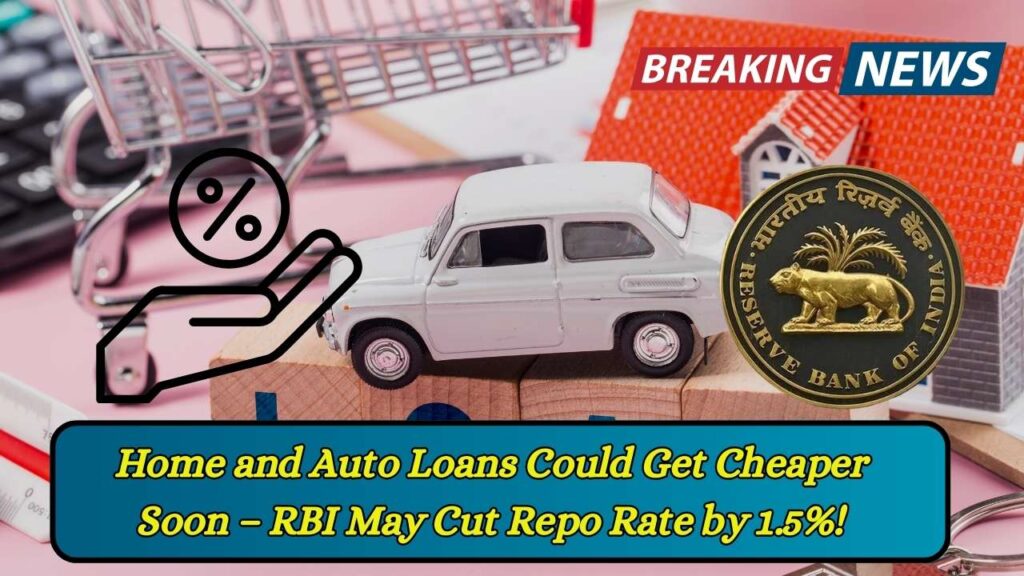Home and Auto Loans Could Get Cheaper Soon – In recent months, borrowers in India have seen a favorable shift in interest rates, thanks to the Reserve Bank of India (RBI) adjusting its monetary policy stance. With speculation that the RBI might cut the repo rate by up to 1.5% soon, there’s a potential for significant savings on home and auto loans. This article dives into how such a reduction could impact loans and the steps borrowers should take to make the most of it.

What Is the Repo Rate, and Why Does It Matter?
The repo rate is the interest rate at which commercial banks borrow funds from the Reserve Bank of India. This rate serves as a benchmark for other interest rates in the economy, including those for home loans, car loans, and other types of credit. When the RBI cuts the repo rate, the cost of borrowing for banks decreases, and they can pass these savings on to consumers by offering lower interest rates on loans.
A reduction in the repo rate means lower EMIs (Equated Monthly Installments) for borrowers, making loans more affordable. If the RBI indeed cuts the repo rate by 1.5%, it could bring down the monthly repayment burden for individuals who have home and auto loans.
Home and Auto Loans Could Get Cheaper Soon
| Topic | Details |
|---|---|
| Expected Rate Cut | RBI may reduce the repo rate by up to 1.5% |
| Impact on Loans | Home and auto loan interest rates may decrease |
| Targeted Loans | Home loans, car loans, and personal loans linked to repo rate |
| Benefits for Borrowers | Lower EMIs, reduced overall loan costs, improved affordability |
| Sources | RBI, Economic Times, Business Today, Reserve Bank of India |
| Official Link | RBI Website |
The possibility of an RBI repo rate cut of 1.5% presents a significant opportunity for borrowers, especially those with home and auto loans. If the rate cut happens, it will lead to lower EMIs, reduced overall costs, and greater affordability for borrowers across the nation. Whether you are planning to refinance, apply for a new loan, or simply want to understand how this policy will affect your finances, now is the time to explore your options.
How Does the Repo Rate Cut Affect Home and Auto Loans?
When the RBI cuts the repo rate, it directly impacts loans that are tied to the benchmark rate, including home loans and auto loans. The impact on monthly payments can be substantial, especially for long-term loans. Here’s how:
Home Loans
For most home loans, interest rates are either linked to the repo rate or the MCLR (Marginal Cost of Funds-based Lending Rate). If the repo rate is reduced by 1.5%, home loan rates are likely to decrease correspondingly, resulting in lower EMIs. For a borrower with a ₹30 lakh home loan, a 1.5% reduction could save them thousands of rupees each month.
Auto Loans
Auto loans, especially those with floating rates, are also linked to the repo rate. A reduction in the repo rate by 1.5% could bring down the interest rate on car loans. This would make buying a car more affordable for many consumers and ease the financial strain on those already servicing a loan.
Personal Loans
Though personal loans are less directly affected by repo rate cuts, many banks offer them at rates linked to benchmarks such as MCLR or external benchmarks like the RLLR (Repo Linked Lending Rate). A repo rate reduction could therefore make personal loans cheaper as well.
Real Estate Sector Boost
Lower home loan interest rates can stimulate the housing market by making property purchases more attractive. This may increase housing demand and potentially provide a boost to the real estate and construction sectors.
Consumer Spending Uplift
When EMIs reduce, people often find themselves with extra disposable income. This can increase consumer spending in other sectors of the economy, boosting overall economic growth.
How to Benefit from the Repo Rate Cut?
If you are in the market for a home or auto loan, or if you are already repaying one, there are a few steps you can take to maximize your savings:
Consider Refinancing Your Loan
If you have an existing home or auto loan with a high interest rate, this is the perfect opportunity to consider refinancing. With a rate cut, your lender might offer you a lower interest rate, which can reduce your EMIs or shorten your loan tenure.
Shop Around for Better Rates
Different lenders respond to rate cuts in various ways. While some pass on the full benefit to borrowers, others might offer only partial reductions. It’s essential to compare offers from various banks and financial institutions before making a decision.
Lock in Lower Rates Early
If you’re thinking of applying for a new loan, doing so early could help you lock in lower rates before they rise again. Interest rates on loans tend to fluctuate based on the RBI’s monetary policy and market conditions.
Check Your Eligibility
Lenders may revise their lending criteria in response to rate cuts. It’s important to ensure your credit score, income level, and other financial factors are in line with the bank’s requirements to get the best rates available.
Track Reset Dates on MCLR Loans
For borrowers with MCLR-linked loans, interest rates do not change immediately with a repo rate cut. These loans adjust at specific reset intervals (e.g., once every 6 months). Make sure you know your reset date to estimate when you’ll benefit from the rate cut.
What to Expect in the Coming Months?
Economic Growth and Inflation
The RBI’s decision to reduce the repo rate is often linked to broader economic conditions, including inflation and growth targets. If inflation remains under control and the economy shows signs of recovery, the RBI may continue to lower rates, benefiting borrowers even further.
Global Factors
International economic conditions, such as global oil prices or trade tensions, can influence the RBI’s decisions. For example, if the global economy faces slowdowns or inflationary pressures, the RBI may hold back from further cuts, depending on the situation.
Further Rate Cuts
Some experts predict that the RBI could lower the repo rate by up to 1.5% in 2025, but this will depend on the trajectory of domestic inflation, fiscal policy, and global economic events. As of now, the reduction seen is a signal that the RBI is focused on stimulating growth and easing financial burdens for consumers.
Impact on Fixed Deposits
While borrowers benefit from lower interest rates, depositors may earn less on Fixed Deposits (FDs). Investors should consider diversifying into other financial instruments to maintain yield.
NaBFID Recruitment 2025 Announced – Check Vacancies, Eligibility and Last Date Today
RNSB Hiring 2025: Apprentice Peon Vacancy Out – Easy Entry-Level Bank Job You Can’t Miss
Central Bank Credit Officer Cut Off 2025, Check Expected Cut-off Marks Category Wise
FAQs about Home and Auto Loans Could Get Cheaper Soon
How does the repo rate affect my loan?
The repo rate directly influences the interest rates on loans, including home and auto loans. When the RBI cuts the repo rate, lenders typically lower their interest rates, reducing your EMIs and making loans more affordable.
Should I refinance my home loan now?
If the RBI cuts the repo rate significantly, this is an excellent time to refinance your home loan, as it could lead to lower interest rates and reduced monthly payments. Check with your lender for new offers.
Will all loans be affected by the repo rate cut?
While loans tied to the repo rate, such as home and auto loans, will be directly impacted, other types of loans, like personal loans or fixed-rate loans, might experience slower or minimal changes.
How much will my EMI decrease with a 1.5% repo rate cut?
For example, on a ₹30 lakh home loan, a reduction of 1.5% in the interest rate could reduce your EMI by ₹3,000 to ₹5,000, depending on the loan tenure and the bank’s policies.
Can I get a better deal on a car loan with the repo rate cut?
Yes, auto loans with floating rates will likely become cheaper with a repo rate cut, lowering your monthly repayments and making car ownership more affordable.
Will my Fixed Deposit interest rate also reduce?
Yes, a cut in the repo rate can lead to lower returns on FDs. Banks often reduce deposit rates after lending rates go down. Consider balancing FDs with mutual funds or bonds if you’re seeking higher returns.









